The best graphics cards for the money: key recommendations
Our at-a-glance look at the whole market.
In this final section of the Digital Foundry graphics card upgrade guide, we bring together all of the key purchasing recommendations found on the previous pages and compile them together in order to give you a single page, at-a-glance look at the entire enthusiast GPU market. AMD's Radeon 300-series updates have made the firm competitive and we're still somewhat conflicted between the R9 390 and the GTX 970, but as things stand, Nvidia is dominating with only the R9 380 and 380X looking unassailable in the sub £200/$250 market sector.
So, what of the future? Are better products en route and when can we expect to see them? Our understanding is that AMD and Nvidia are happy with their product line-ups for now. All of the products we've reviewed here are based on vintage 2011 28nm processing technology and both vendors have effectively pushed that level of fabrication to the limit. The next step is a reduction to 16nm or 14nm, with 3D transistors - and we're unlikely to see any products using this until well into 2016.
In the immediate future, we may well see some repositioning of existing products in the stack, and the re-release of more vintage silicon (AMD has released a more powerful version of the R7 370 in China - the imaginatively titled R7 370X, effectively the same as the older 270X) but for now, this is how the market looks in the West.
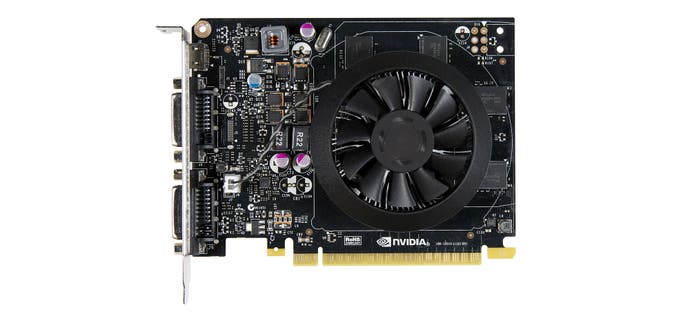
The best graphics card under £100 / $130: GeForce GTX 750 Ti
Honourable mention: Radeon R7 360
AMD's Radeon R7 360 seems to be a worthy replacement for the older R7 260X, and in our experience, just equalising clocks (1100MHz on the core, 1625MHz on RAM) produces an identical level of performance to the prior model, which makes us wonder whether there are some models out there which are simply rebadged cards. This is curious bearing in mind that on paper at least, the R7 360 is actually a downgraded version of the 260X. Still, with careful settings management, the R7 360 easily offers comparable performance to Xbox One, and gets within striking distance of PlayStation 4 performance on multi-platform titles. But in the sub-£100 range, the GTX 750 Ti is simply unstoppable.
At stock speeds, Nvidia's budget offering offers frame-rates unerringly in line with what we see on PlayStation 4, and on the games that don't quite match Sony's console, simply bumping up GPU core frequency by 200MHz and RAM by 400MHz allows you to push beyond console settings - something we saw most recently in Metal Gear Solid 5, where we attained nigh-on identical frame-rates with improved image quality over both console versions. Nvidia's drivers also include support for adaptive and half-rate adaptive v-sync - something lacking on the AMD side. This allows you to easily cap frame-rates to 30fps and 60fps, introducing tearing only when the card can't sustain the frame-rate - it's a trick used extensively on console, and it's used for a reason. It's all about getting the smoothest performance with limited GPU resources.
So, higher performance, more options for getting the smoothest gameplay... that's why the GTX 750 Ti is our pick for our own £300 budget PC build.
Buy the GTX 750 Ti or R7 360 from Amazon with free shipping:
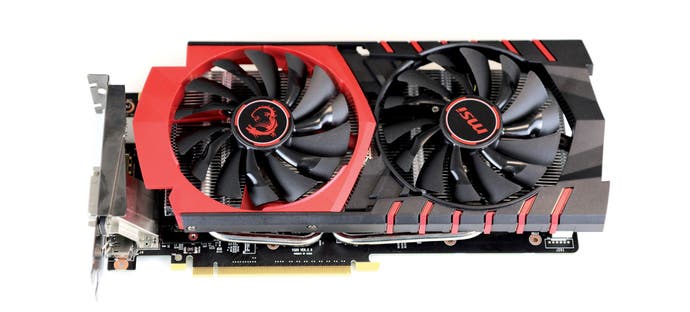
The best graphics card under £130 / $160: GeForce GTX 950
Honourable mention: Radeon R7 370
The R7 370 is a good product but also a somewhat cynical one. Put simply, it is priced as a replacement for the old R9 270 and 270X, yet it is not as powerful as either of them, with 1280 shader cores in the older cards and just 1024 in the replacement. Bearing in mind AMD's traditional strength in its value graphics heartland, this is somewhat disappointing. The R7 370 really is little more than an overclocked Radeon HD 7850 - a card that's three-and-a-half years old now.
By default, this makes the GTX 950 the one to get. It's generally faster (though how much faster depends on whatever factory overclock you end up with - this will vary between cards), it's stupendously easy to overclock for even higher performance and it comes with that highly useful adaptive v-sync we talked about earlier. On top of that, the fact that it is based on more modern silicon means it is more capable in other regards too. It can encode and decode the latest generation of media codecs, including Google's VP9 and h.265, better known as HEVC. Our only issue with the GTX 950 is its pricing. Nvidia is charging a £10/$10 premium, meaning that it is perilously close in price to the better GTX 960, and indeed 4GB versions of the R7 370. Hopefully market forces will bring it down to the £120 price-point it should sell for.
Buy the GTX 950 or R7 370 from Amazon with free shipping:
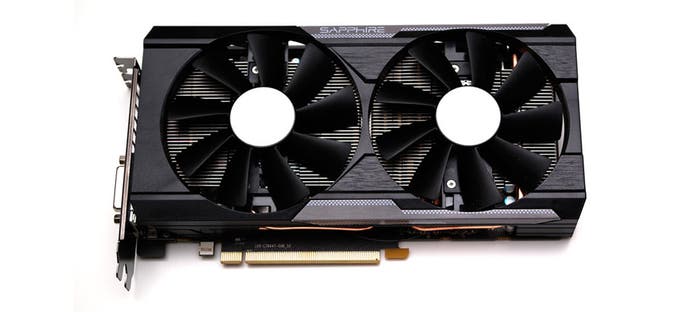
The best graphics card under £200 / $250: Radeon R9 380/380X
Honourable mention: GTX 960
Weighing up the pros and cons for the two contenders here, this is a really tough call, but at the end of the day, performance is king and the Radeon R9 380 is faster in our tests than its GeForce equivalent. Another plus point is that the R9 380 is based around one of the more modern processors AMD has produced, so later features are available - such as the ability to downscale higher resolutions to 1080p for improved anti-aliasing. The R9 380X is effectively the same thing based on the same processor - you pay an extra 10 per cent and get a corresponding level of additional performance. It's good, but it's not a game-changer.
But despite the performance differential, the GTX 960 still has much to offer. Of course, it's an excellent overclocker but also, for those interesting in media playback, its support for encode and decode of the latest HEVC codec is really useful, plus there's still the sense that in many titles, Nvidia produces more consistent, less 'hitchy' gameplay. A good case in point here is The Witcher 3, which seems to stutter on AMD in city areas, but not on Nvidia. The green team's lower CPU utilisation also makes the GTX 960 the better buy for those running less capable processors such as the Core i3 line, for example. However, if you can afford £200 on a graphics card, we suspect that you can also afford a Core i5, where the R9 380 is an excellent buy.
Buy the R9 380 or GTX 960 from Amazon with free shipping:
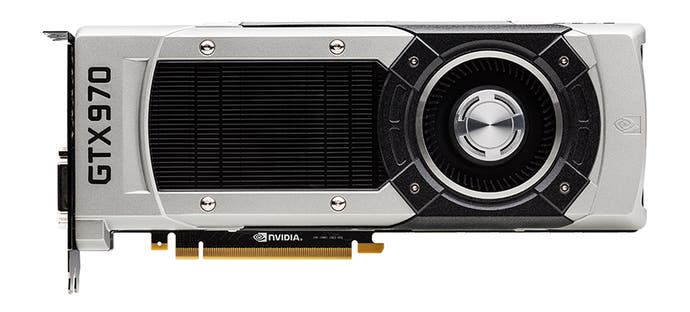
The best graphics card under £250 / $330: GTX 970
Honourable mention: R9 390
It was always on a knife-edge, but we've decided to flip our verdict here. Previously, we opted for the R9 390 owing to its future-proof VRAM and excellent performance, but recent issues with driver support for key titles such as Fallout 4 and Just Cause 3 have highlighted that weak software support really impacts the Radeon ownership experience. Meanwhile, Nvidia's GTX 970 has continued to flourish with day one driver updates for every major release. If there are issues with the controversial 3.5GB/0.5GB split in VRAM, we have yet to see them manifest outside of multi-card SLI set-ups, and for 1080p gameplay in particular, the strong performance plus superb overclocking performance puts the GTX 970 on top.
But AMD deserves a huge amount of kudos in responding to the arrival of the GTX 970 last year, which gave the R9 290 a good kicking and even beat the 290X in many scenarios. Overclocking the Hawaii core and upgrading the memory has given AMD the performance boost it needs to take the fight to Nvidia and to win in straight, out-of-the-box performance at 1440p. Also, the R9 390 brute-forces its way past any potential VRAM issues by providing a mammoth 8GB of GDDR5. It may well be the case that games won't utilise it, but to be frank, it's kind of reassuring that it's there.
Buy the R9 390 or GTX 970 from Amazon with free shipping:
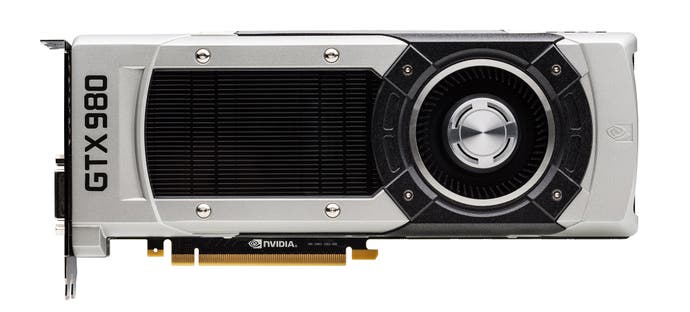
The best graphics card under £400 / $500: GTX 980
Honourable mention: R9 390X
This market category is a curious one. In our opinion, the R9 390X and the GTX 980 do not provide a genuinely transformative gameplay experience compared to the much cheaper R9 390 and GTX 970, so the overall value proposition does seem a little suspect. This isn't helped by the fact that the GTX 980 Ti and the R9 Fury X lurk at the £510/$650 price-point, offering a tangible leap in performance. Sure, you're paying an extra £110/$150, but some might say that if you're budgeting so much money for a GPU, you may as well go for the best you can get.
Still, within its price-tier, the GTX 980 is our pick - simply because its combination of efficiency and overclocking is untouchable in this area. AMD's strategy of overclocking its Hawaii core and ramping up memory frequencies paid off pretty well with the R9 390, but there's the sense that the same strategy only goes so far with the 390X, which is the most power-hungry and the hottest GPU we've ever tested. The R9 390 had performance leadership, but the situation is far less clear with the 390X. Meanwhile, the GTX 980 has the performance, it has the overclocking headroom, and it works just fine in most gaming cases.
Buy the GTX 980 or R9 390X from Amazon with free shipping:
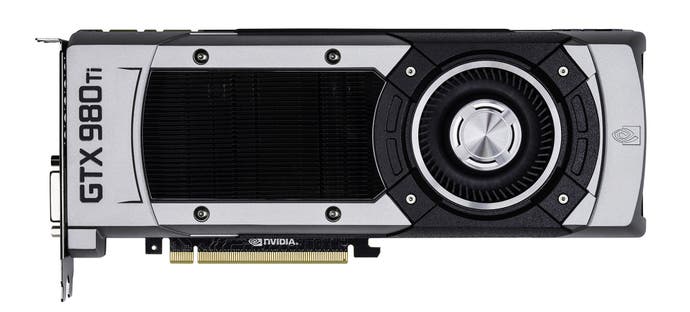
The best graphics card over £400/$500: GeForce GTX 980 Ti
Honourable mention: Radeon R9 Nano
The GTX 980 Ti may not be the fastest card in the collection, but what it loses in terms of performance to the top-end Titan X is easily forgivable bearing in mind that it is $350 cheaper, and can easily be overclocked to move way beyond stock performance on Nvidia's thousand dollar offering. AMD's Fury X is a worthy contender - but only really at 4K resolutions, and even there any performance advantage is lost once the GTX 980 Ti's overclocking capabilities are factored in. In short, if you want the best balance of price vs performance in this category, the GTX 980 Ti is unmatched.
But with that said, the R9 Nano is worthy of consideration if you are building a small form-factor PC - if you can stomach the colossal $650 price-tag. Nvidia simply doesn't have a card offering the same kind of performance in such a tiny chassis - but we offer this recommendation with a couple of caveats. Firstly, its 1080p turn-out isn't great, to the point where even the GTX 970 at half the price can be competitive on some games. And secondly, many mini-ITX SFF cases can hold a GTX 980 Ti or a Fury X. Nvidia's card certainly won't be as quiet in this scenario, but it'll definitely be faster. We suspect that the Nano is the first in a new breed of GPU, and where that product leads, smaller gaming cases will follow.
Buy the GTX 980 Ti or R9 Nano from Amazon with free shipping:
- Previous page: The best graphics cards over £400 / $500
- Return to the graphics card upgrade guide index.
